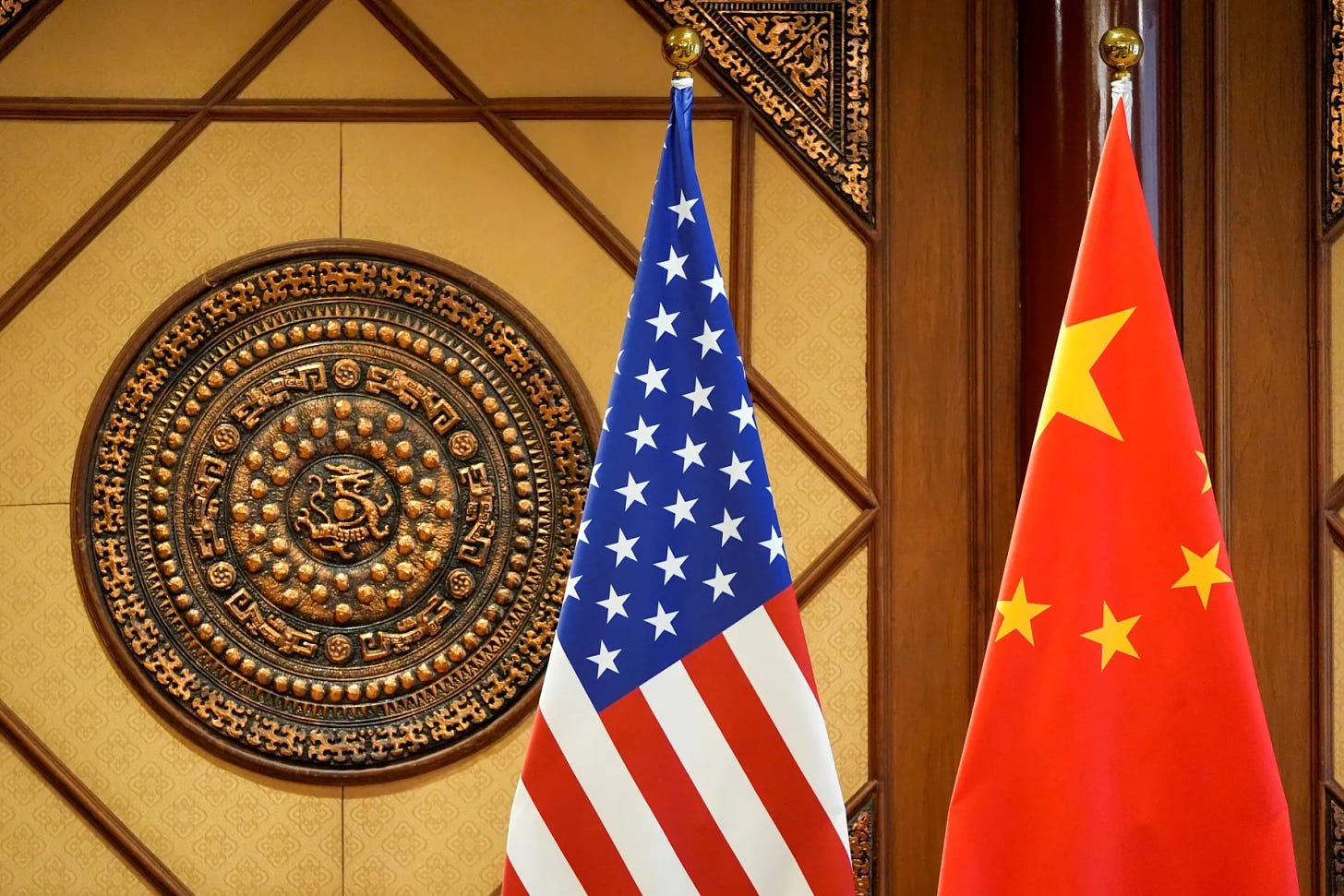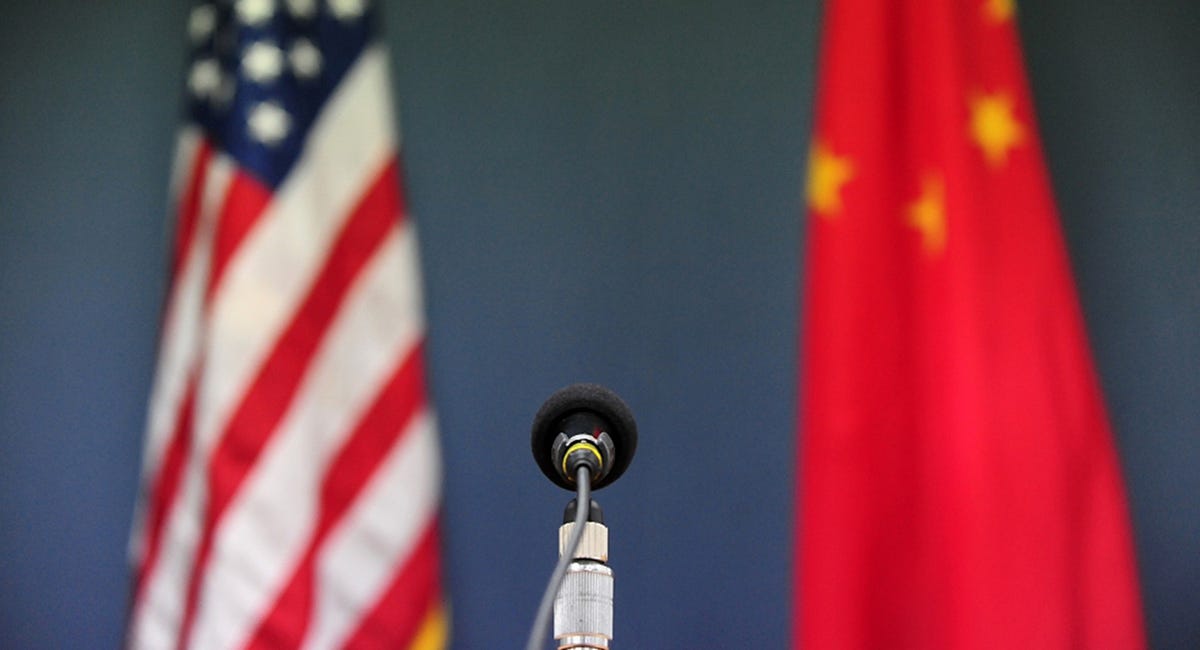GAO Cheng on U.S. Strategic Competition against China and Evolution of Asia-Pacific Regional Order
The regional synergistic development model will go beyond the group politics model, becoming the mainstream of the Asia-Pacific order.
Welcome to the 7th edition of our weekly newsletter! I recently returned from two conferences in the UK and Italy: the China-Europe Artificial Intelligence Conference in Oxford and the China-US Artificial Intelligence Conference in Venice. Both Track II meetings were incredibly enlightening, and I’m planning to write an article on China-U.S. AI cooperation soon. Stay tuned!
ChinAffairs+ is a weekly newsletter that shares Chinese academic articles focused on topics such as China’s foreign policy, China-U.S. relations, China-European relations, and more. This newsletter was co-founded by me and my research assistant, ZHANG Xueyu. I am SUN Chenghao, a fellow with the Center for International Security and Strategy (CISS) at Tsinghua University, and currently a visiting scholar at the Paul Tsai China Center of Yale Law School in the United States.
Through carefully selected Chinese academic articles, we aim to provide you with key insights into the issues that China's academic and strategic communities are focused on. We will highlight why each article matters and the most important takeaways. Questions or criticisms may be addressed to sunchenghao@tsinghua.edu.cn

Summary
In the military, economic, technological and ideological field, the United States is trying to create a bloc political ecology to suppress and isolate China in the Asia-Pacific region, which presents certain "Cold War" characteristics. But the current China-U.S. relations are not in the old "Cold War" mode, and will not escalate into a direct confrontation between the two parallel military alliance systems and ideological camps in the case of economic isolation.
Based on that, this article focused on the direction of the Asia-Pacific order in the context of U.S. strategic competition towards China, indicating that the order will depend more on the interaction between China and its neighbouring countries. Then the author puts forward proposals for China to play a more active role as an end-market and a major provider of public goods in the reconstruction of the industrial chain, contributing more to the stability and prosperity of the region. If this is the case, the regional synergistic development model advocated by China will transcend the group politics model promoted by the U.S., ultimately becoming the mainstream approach in the Asia-Pacific order.
Why It Matters
In recent years, the rise of global multipolarity has weakened U.S. unipolar dominance, leading to a decline in the U.S.-led liberal international order. Meanwhile, the clash between China and the U.S., driven by differing development and governance models, has intensified. This strategic rivalry is accelerating the transformation of the global order, with U.S. policies of "decoupling" and "de-risking" from China reshaping supply chains. Many Chinese scholars believe in the Asia-Pacific, the U.S. is attempting to compete with China by building a regional order based on bloc politics, exclusive economic clubs, and a Western-centric alliance of values.
In the context of U.S. strategic competition towards China, there have been numerous analytical articles regarding changes in the situation in the Asia-Pacific region. This article not only analyzes the political, military, and economic shifts in the Asia-Pacific but also provides recommendations on how China should respond, making it significant for understanding how China perceives the situation in the region and reacts accordingly.
The article believes that, under U.S. strategic competition towards China, many countries in the Asia-Pacific continue to adopt a strategy of 'hedging', maintaining relations with both China and the U.S., rather than firmly aligning with one side. However, as the U.S. continues to strengthen its alliances, countries like Australia, Japan, and India are increasingly showing tendencies to align their foreign policies with the U.S., which creates certain strategic pressure on China. At the same time, the article emphasizes that China-U.S. relationship is not a 'Cold War' nor merely an ideological competition, but rather a contest between two development logics and global governance models.
Key Points
Bloc Politics(集团政治) : U.S. Policy Trends in the Asia-Pacific Region
With the rise of China, the U.S. strategic position towards China has been rising, regarding it as the U.S. "priority and only global competitor". In the Asia-Pacific region, compared with the Trump administration's "Indo-Pacific strategy", the Biden administration has placed more emphasis on the return of U.S. leadership, focusing on the deeper network of allies and partnerships. At the same time, it draws in extra-territorial allies to intervene, bundling security, politics, economics, and ideology in depth, to create an all-encompassing bloc political ecology towards China.
Military Security: Strengthen U.S. partnership to isolate and suppress China
For allied forces: Through the U.S. military presence in allied countries, the U.S.-Japan-India-Australia Quadripartite Security Dialogue (QUAD), the U.S.-Britain-Australia Trilateral Partnership (AUKUS) and other alliance mechanisms, the United States has continually interacted with its core allies on multiple fronts, constructing a U.S.-led regional military security integration system. Via frequent joint military exercises targeted at China (as the hypothetical enemy), the "sense of identity" is enhanced.
For emerging partners: The U.S. has further expanded its alliance through regular military contacts, institutional defense trade and technical cooperation, multilateral mechanisms (such as the G7 summits), deep logistical assistance, and information-sharing cooperation. At the same time, the U.S. has adopted a "layered approach" strategy, dividing ASEAN and then focusing on drawing the Philippines, Indonesia and Vietnam; encouraging NATO, the EU, and other extraterritorial powers to intervene in Asia-Pacific affairs, and deepening the integration of Eurasian alliance; setting up the U.S.-Australia-Japan-UK-New Zealand "Blue Pacific Partnership" alliance system to counterbalance to China.
Economic Sphere——Create club-like organizations that exclude China to ensure U.S. dominance:The United States has launched the "Indo-Pacific Economic Framework" (IPEF), accelerated the implementation of the "friendly onshore outsourcing"(“友岸外包”) and "small yard high fence" policies, strived to break through the temporal and spatial limitations of supply chain to include allies who share the "common values" with the U.S., making the creation of the so-called "diversified and resilient" supply chain as an important part of the "de-risking" strategy towards China.
High Technology——Implement "break the chain"(“阻链”) and "block the flow"(“断流”) towards China:The United States has successively proposed the "Security Equipment Act" (2021), "Chip and Technology Act" (2022), "Declaration on the Future of the Internet" and other bills, especially restricting the development of China's chip technology and semiconductor industry. Meanwhile, the U.S. pulls together Japan, South Korea and Chinese Taiwan to form the "Chip Quadrilateral Alliance"(“芯片四方联盟”), aiming to build high-tech networks and supply chains that exclude China and constrain China by formulating new rules for the Internet.
Ideological struggle——Promote a "values alliance" to reverse the momentum of China's rise: Economically, the U.S. speculates on the "China threat theory" and is committed to rebuilding the so-called "free economic order" led by the U.S. in the Indo-Pacific region. Politically, the U.S. emphasizes the common value bond between the U.S. and its allies, openly labeling China, Russia, and other big powers as the so-called "authoritarian countries" "coercive diplomacy", so it can elevate the competition among great powers to a "democratic" and "authoritarian" struggle, prompting allies to work together with them. The U.S. attaches particular importance to its alliance with South-East Asia, attempting to undermine the close interaction between China and emerging market countries or developing countries with its "wedge strategy", which will lead to division and confrontation in the Asia-Pacific region.
"Cold-War-like" Inkling : The impact of the U.S. Group Politics on the Asia-Pacific order
The U.S.-Soviet Cold War was characterized by competitive military alliances, independent economic systems, and ideological confrontation. Currently, the U.S. full-scale preventive suppression of China aroused international concerns about the "return" of the Cold War. Although it is unlikely to repeat the same old path of the Cold War, the Asia-Pacific region is beginning to take on the embryonic form of a bloc political order, showing signs of a "Cold War-like" phenomenon.
Essential Differences between the China-U.S. Current Confrontation and the Cold War
Firstly, there are no two tit-for-tat military alliance systems in the Asia-Pacific region. On the one hand, because of China's non-aligned policy, the Asia-Pacific region will not form a China-led military alliance system. On the other hand, it is difficult for the United States to form a NATO-style multilateral military alliance against China in the Asia-Pacific region.
Secondly, it is difficult to form two parallel economic systems in the Asia-Pacific region. With the deeper level of globalization, China and the United States have a high degree of economic interdependence, which means they will not be fully "decoupled" from each other, otherwise, it will have a drastic impact on the United States and global industrial chain.
Finally, the China-U.S. ideological competition is reflected in different development and governance models rather than the "two camps". With the development of technology, the influence of the "mainstream" ideology promoted by the U.S. after the end of the Cold War is declining, and it is more often used to draw other countries together to isolate China under the banner of "Western democratic values". On the other hand, China has always adhered to the correct views of righteousness and profit(正确义利观) in its foreign relations, which is highly appreciated by most countries.
The emergence of "Cold-War-like" symptoms in the Asia-Pacific region
Firstly, the U.S. is creating a political ecology of great power blocs against China. The trend of "choosing sides" between competing regional powers and U.S. allies is becoming more pronounced. Driven by the U.S. "Indo-Pacific Strategy," the U.S. is collaborating with Japan and Australia while also engaging India. These countries are shifting from a "balancing strategy" to closer alignment with the U.S. against China, ensuring strategic consistency and operational coordination.
Secondly, the U.S. policies declined the economic interdependence between China and the West, and partial industrial "decoupling" occurred. The global pandemic has accelerated "decoupling," especially in high-tech sectors, as regional powers focus on securing industrial supply chains, prompting a reconstruction of these chains in the Asia-Pacific and beyond. Meanwhile, the U.S. is using IPEF to establish a China-exclusive economic zone, affecting supply chain stability.
In response, China is reshaping peripheral value chains through the Belt and Road Initiative and RCEP, creating a dual-circular economic structure that promotes regional economic recovery and reduces dependence on developed Western economies, while upgrading the industrial structure of China and neighboring developing nations.
Thirdly, the cultural divergence between China and the West, characterized by differences in development and governance models, has intensified. Western societies are becoming more and more complex about China's rise. The current positioning of the U.S. towards China is ambiguous, somewhere between a strategic competitor and a "hostile state". China's development and governance model has shattered the myth of uniqueness and universality of the Western model, and its global influence continues to grow. Most of the world's non-Western countries are now making side-by-side comparisons between the Chinese and Western models as observers.
Hedge and Balance : The Direction of Order in the Asia-Pacific Region under U.S. Strategic Competition towards China
In the Asia-Pacific region, the U.S. is attempting to create a bloc political ecology and steer the region from the theme of openness and inclusion to the realm of security and ideology. Under the coercion and inducement of the U.S., there is a clear tendency for its important allies in the Asia-Pacific region and regional powers that are in strategic competition with China to choose sides. At the same time, however, most countries in the Asia-Pacific region are striving to maintain their strategic independence, which is the basis for China to shape a favourable strategic environment in its neighbourhood and maintain a regional order based on the theme of peace and development.
Firstly, most countries in the Asia-Pacific region tend to remain neutral rather than taking sides.
In South Asia, most countries maintain good relations with China through the Belt and Road Initiative. In East Asia, DPRK and the U.S. remain adversarial, while Mongolia balances its relations between both. Southeast Asian countries, influenced by colonial history and the Cold War, generally adopt a hedging strategy. ASEAN emphasizes its commitment to "peace, security, neutrality, and stability" in the region and has been largely indifferent to the Indo-Pacific Strategy. China's efforts to foster a favorable political environment for its development reflect a broader trend.
Secondly, China will gradually replace the U.S. as the center of the Asia-Pacific economic order.
Historically, as intermediate roles in the global and regional industrial chains, East Asian economies have long relied on the final consumer goods markets of Europe and the U.S. However, in the post-epidemic era, economies are passively or actively transferring their industrial chains to their own countries or neighbouring regions. Moreover, the U.S. has gradually lost its willingness and ability to provide the Asia-Pacific region with economic engines and public products in the field of governance. The neighbouring countries are looking forward to China's active role in the reconstruction of the regional industrial chain.
Thirdly, most countries today are more concerned with the construction of a new international order and the contribution of great powers than with ideological disputes.
Despite the United States' efforts to create an ideologically based coterie to suppress China, China's contributions to the global arena have given rise to goodwill and expectations in many countries for a more diverse and balanced world. While Western societies are concerned that China's rise will disrupt the existing international order, most countries in the Asia-Pacific have no intention of joining the camp of ideological confrontation but rather have a clear willingness to promote regional economic cooperation, especially with a focus on China's role in regional supply chains in the post-pandemic era.
Conclusion:Non-Western countries, particularly China's neighbors, prioritize their own development and governance, evaluating which model—China's or the U.S.'s—can bring prosperity and stability. The diminishing appeal of the Western development model and the U.S.'s declining leadership in global governance have led many countries to question the "universal values" and dominant international order of the West. Most Asia-Pacific nations seek to maintain strategic independence. If the alignment of development models between China and these countries increases and more public goods are offered in global and regional governance, non-Western countries may gain confidence in China's approach. This could prevent the future world and Asia-Pacific order from succumbing to the bloc politics that the U.S. aims to create.
About the Author
GAO Cheng 高程:She is currently the Deputy Director of the Latin American Studies Institute, a Senior Research Fellow, and a doctoral supervisor in International Politics with Chinese Academy of Social Sciences (CASS). She holds a Bachelor's degree in Law from Peking University and a Master's and Ph.D. in Economics from the Chinese Academy of Social Sciences' Department of World Economy and Politics. She has previously served as the Deputy Director of the Economic Research Office and the Director and Executive Editor of the editorial board of Contemporary Asia-Pacific(《当代亚太》). Additionally, she is the Director of the China-Australia, New Zealand, and South Pacific Research Center at CASS, Vice President of the China Latin American History Research Association, Executive Director of the China Emerging Economies Society, Executive Director of the China International Relations Journal Research Association, Council Member of the China Society of World Economics, and Council Member of the China International Relations Society.
About the publication
The Chinese version of the article was published by Contemporary World Journal Press(《当代世界》). The journal, supervised by the International Department of the Central Committee of the Communist Party of China (IDCPC), is a comprehensive bimonthly periodical distributed both in China and overseas. The magazine serves as an important platform for introducing and explaining Xi Jinping Thought on Socialism with Chinese Characteristics and Xi Jinping Thought on Foreign Affairs, as well as major diplomacy theories and practices with Chinese characteristics especially the innovative achievements of the Party's work in foreign affairs. It brings together a wealth of views from experts and think tanks around the world on international issues, and offers in-depth analysis of the contemporary world, dynamic changes to the international landscape, as well as China's foreign policies and practices.
QI Haixia: The Risks of Hedging in China-U.S. Competition
Welcome to the 4th edition of our weekly newsletter! Recently, I traveled to Washington for research and engaged in discussions with some American scholars. I noticed that there seems to be a debate in the U.S. strategic community regarding U.S. policy toward China. While the scale and scope of this debate are clearly not as extensive as in 2014-2015, i…









